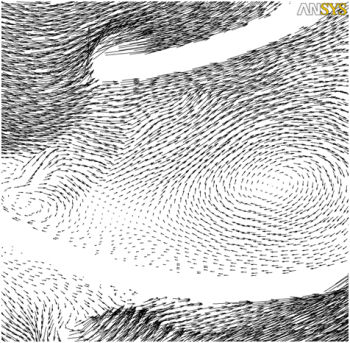
Transient effects play a major role in turbomachinery such as pumps, compressors or turbines. Fluctuations with a large amplitude, such as those caused by detachments under partial load, are of particular importance. The fluctuations are associated with changing loads on the components due to fluid forces and can therefore lead to vibration problems in the event of resonance. In the low partial load range, detachments occur due to incorrect flow at the leading edge, which are not stable but circulate in the machine. The rotational speed of the vortex areas is generally lower than the rotational speed of the impeller, but is not known at the design stage. This phenomenon is therefore called rotating stall. The frequency of the rotating stall is of great importance due to the possible vibration excitation and can be determined either in experiments or with the help of modern simulation methods. At the Institute, the partial load behavior of a pump is investigated with the aid of computational fluid dynamics (CFD). The treatment of turbulence plays a decisive role here. Classical turbulence modeling is only suitable to a limited extent for flows with separation. Methods such as LES (Large Eddy Simulation), which completely or partially resolve turbulent structures, are not yet suitable for use in pump flows due to the enormous computational effort involved. However, there are new hybrid developments, such as DES (Detached Eddy Simulation), which calculate adjacent flows with a classic turbulence model and detached areas with LES-like approaches. The advantage of these methods is a drastic reduction in the number of grid points compared to an LES calculation for the entire fluid volume. Nevertheless, this method requires high-performance computers in order to generate results in reasonable computing times (in the range of days). As part of the project, hybrid models for the calculation of turbulent flows are first validated. After evaluating simple test cases documented in the literature, the suitability of the model for simulating the rotating stall is investigated. Detailed measurements on a pump are available for comparison. In further investigations, the influence of the inflow and outflow conditions on the frequency and onset of rotating stall will be studied. To this end, volute casings will be designed and optimized with a view to minimizing rotor-stator interaction. Efficiency is also taken into account as the most important design criterion. The inflow conditions are taken into account by means of typical installations in the suction line such as diffusers or elbows. As a result, it will be demonstrated that the use of CFD can make an important contribution to the prediction of possible vibration problems in impellers.
Publications
- A. Lucius, G. Brenner: "Unsteady CFD Simulations of a Pump in Part Load Conditions Using a Hybrid LES RANS Model", to appear in Conference on Modelling Fluid Flow, Budapest 2009
- A. Lucius, G. Brenner: "3D time accurate simulations of a centrifugal compressor" to appear in 20th International Conference on Parallel Computational Fluid Dynamics, Lyon 2008
